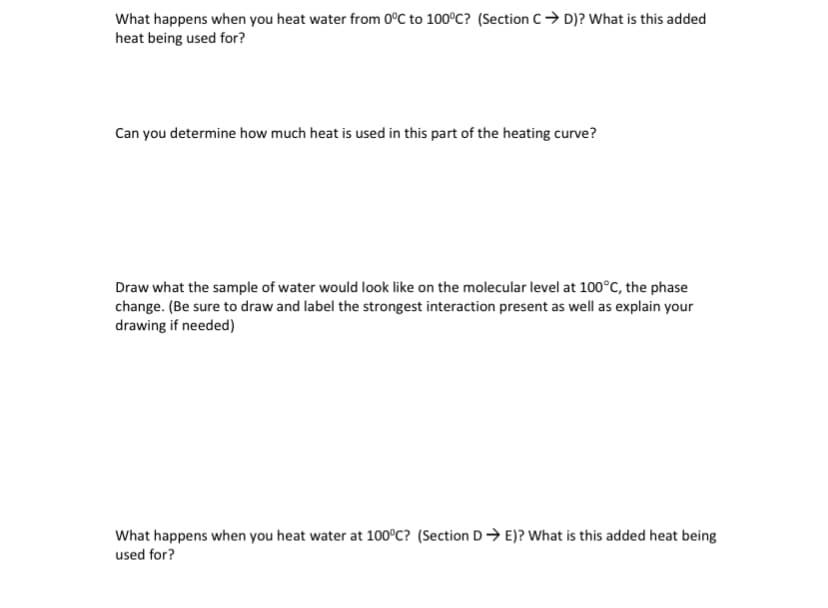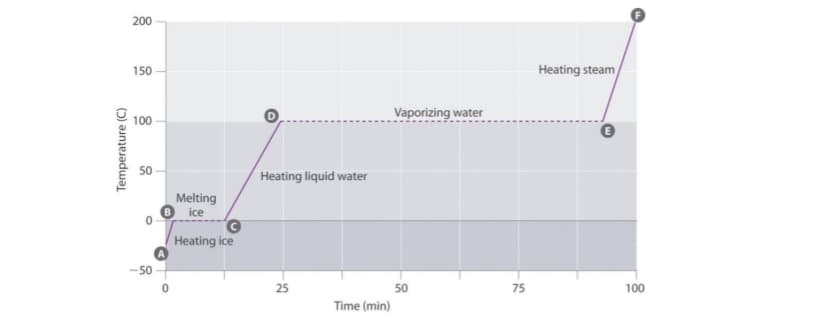What happens when you heat water from 0°C to 100°C? (Section C> D)? What is this added heat being used for? Can you determine how much heat is used in this part of the heating curve? Draw what the sample of water would look like on the molecular level at 100°C, the phase change. (Be sure to draw and label the strongest interaction present as well as explain your drawing if needed) What happens when you heat water at 100°C? (Section D→ E)? What is this added heat being used for?
What happens when you heat water from 0°C to 100°C? (Section C> D)? What is this added heat being used for? Can you determine how much heat is used in this part of the heating curve? Draw what the sample of water would look like on the molecular level at 100°C, the phase change. (Be sure to draw and label the strongest interaction present as well as explain your drawing if needed) What happens when you heat water at 100°C? (Section D→ E)? What is this added heat being used for?
Principles of Modern Chemistry
8th Edition
ISBN:9781305079113
Author:David W. Oxtoby, H. Pat Gillis, Laurie J. Butler
Publisher:David W. Oxtoby, H. Pat Gillis, Laurie J. Butler
Chapter10: Solids, Liquids, And Phase Transitions
Section: Chapter Questions
Problem 48P
Related questions
Question
Please

Transcribed Image Text:What happens when you heat water from 0°C to 100°C? (Section C> D)? What is this added
heat being used for?
Can you determine how much heat is used in this part of the heating curve?
Draw what the sample of water would look like on the molecular level at 100°C, the phase
change. (Be sure to draw and label the strongest interaction present as well as explain your
drawing if needed)
What happens when you heat water at 100°C? (Section D → E)? What is this added heat being
used for?

Transcribed Image Text:200
150
Heating steam
Vaporizing water
100
50
Heating liquid water
Melting
ice
Heating ice
-50
25
50
75
100
Time (min)
Temperature (C)
Expert Solution
This question has been solved!
Explore an expertly crafted, step-by-step solution for a thorough understanding of key concepts.
Step by step
Solved in 4 steps with 1 images

Knowledge Booster
Learn more about
Need a deep-dive on the concept behind this application? Look no further. Learn more about this topic, chemistry and related others by exploring similar questions and additional content below.Recommended textbooks for you

Principles of Modern Chemistry
Chemistry
ISBN:
9781305079113
Author:
David W. Oxtoby, H. Pat Gillis, Laurie J. Butler
Publisher:
Cengage Learning

Chemistry & Chemical Reactivity
Chemistry
ISBN:
9781133949640
Author:
John C. Kotz, Paul M. Treichel, John Townsend, David Treichel
Publisher:
Cengage Learning

Chemistry: The Molecular Science
Chemistry
ISBN:
9781285199047
Author:
John W. Moore, Conrad L. Stanitski
Publisher:
Cengage Learning

Principles of Modern Chemistry
Chemistry
ISBN:
9781305079113
Author:
David W. Oxtoby, H. Pat Gillis, Laurie J. Butler
Publisher:
Cengage Learning

Chemistry & Chemical Reactivity
Chemistry
ISBN:
9781133949640
Author:
John C. Kotz, Paul M. Treichel, John Townsend, David Treichel
Publisher:
Cengage Learning

Chemistry: The Molecular Science
Chemistry
ISBN:
9781285199047
Author:
John W. Moore, Conrad L. Stanitski
Publisher:
Cengage Learning

Chemistry: Principles and Reactions
Chemistry
ISBN:
9781305079373
Author:
William L. Masterton, Cecile N. Hurley
Publisher:
Cengage Learning

Chemistry & Chemical Reactivity
Chemistry
ISBN:
9781337399074
Author:
John C. Kotz, Paul M. Treichel, John Townsend, David Treichel
Publisher:
Cengage Learning

Chemistry for Engineering Students
Chemistry
ISBN:
9781337398909
Author:
Lawrence S. Brown, Tom Holme
Publisher:
Cengage Learning